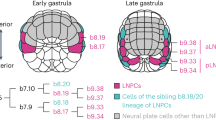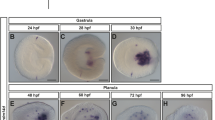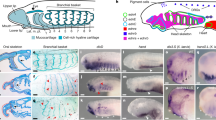Abstract
In ascidian tunicates, the metamorphic transition from larva to adult is accompanied by dynamic changes in the body plan. For instance, the central nervous system (CNS) is subjected to extensive rearrangement because its regulating larval organs are lost and new adult organs are created1. To understand how the adult CNS is reconstructed, we traced the fate of larval CNS cells during ascidian metamorphosis by using transgenic animals and imaging technologies with photoconvertible fluorescent proteins2. Here we show that most parts of the ascidian larval CNS, except for the tail nerve cord, are maintained during metamorphosis and recruited to form the adult CNS. We also show that most of the larval neurons disappear and only a subset of cholinergic motor neurons and glutamatergic neurons are retained. Finally, we demonstrate that ependymal cells of the larval CNS contribute to the construction of the adult CNS and that some differentiate into neurons in the adult CNS. An unexpected role of ependymal cells highlighted by this study is that they serve as neural stem-like cells to reconstruct the adult nervous network during chordate metamorphosis. Consequently, the plasticity of non-neuronal ependymal cells and neuronal cells in chordates should be re-examined by future studies3,4.
This is a preview of subscription content, access via your institution
Access options
Subscribe to this journal
Receive 51 print issues and online access
$199.00 per year
only $3.90 per issue
Buy this article
- Purchase on Springer Link
- Instant access to full article PDF
Prices may be subject to local taxes which are calculated during checkout



Similar content being viewed by others
References
Nielsen, C. Larval and adult brains. Evol. Dev. 7, 483–489 (2005)
Ando, R., Hama, H., Yamamoto-Hino, M., Mizuno, H. & Miyawaki, A. An optical marker based on the UV-induced green-to-red photoconversion of a fluorescent protein. Proc. Natl Acad. Sci. USA 99, 12651–12656 (2002)
Barres, B. A. The mystery and magic of glia: a perspective on their roles in health and disease. Neuron 60, 430–440 (2008)
Allen, N. J. & Barres, B. A. Glia – more than just brain glue. Nature 457, 675–677 (2009)
Satoh, N. Developmental Biology of Ascidians (Cambridge University Press, 1994)
Wada, H., Saiga, H., Satoh, N. & Holland, P. W. Tripartite organization of the ancestral chordate brain and the antiquity of placodes: insight from ascidian Pax-2/5/8, Hox and Otx genes. Development 125, 1113–1122 (1998)
Manni, L. et al. Neurogenic and non-neurogenic placodes in ascidians. J. Exp. Zool. B 302, 483–504 (2004)
Manni, L., Agnoletto, A., Zaniolo, G. & Burighel, P. Stomodeal and neurohypophysial placodes in Ciona intestinalis: insights into the origin of the pituitary gland. J. Exp. Zool. B 304, 324–339 (2005)
Dufour, H. D. et al. Precraniate origin of cranial motoneurons. Proc. Natl Acad. Sci. USA 103, 8727–8732 (2006)
Kusakabe, T., Yoshida, R., Ikeda, Y. & Tsuda, M. Computational discovery of DNA motifs associated with cell type-specific gene expression in Ciona . Dev. Biol. 276, 563–580 (2004)
Tarallo, R. & Sordino, P. Time course of programmed cell death in Ciona intestinalis in relation to mitotic activity and MAPK signaling. Dev. Dyn. 230, 251–262 (2004)
Katz, M. J. Comparative anatomy of the tunicate tadpole Ciona intestinalis . Biol. Bull. 164, 1–27 (1983)
Nicol, D. & Meinertzhagen, I. A. Cell counts and maps in the larval central nervous system of the ascidian Ciona intestinalis (L.). J. Comp. Neurol. 309, 415–429 (1991)
Horie, T., Kusakabe, T. & Tsuda, M. Glutamatergic networks in the Ciona intestinalis larva. J. Comp. Neurol. 508, 249–263 (2008)
Horie, T., Nakagawa, M., Sasakura, Y. & Kusakabe, T. G. Cell type and function of neurons in the ascidian nervous system. Dev. Growth Differ. 51, 207–220 (2009)
Horie, T., Nakagawa, M., Sasakura, Y., Kusakabe, T. G. & Tsuda, M. Simple motor system of the ascidian larva: neuronal complex comprising putative cholinergic and GABAergic/glycinergic neurons. Zool. Sci. 27, 181–190 (2010)
Takamura, K., Egawa, T., Ohnishi, S., Okada, T. & Fukuoka, T. Developmental expression of ascidian neurotransmitter synthesis genes. I. Choline acetyltransferase and acetylcholine transporter genes. Dev. Genes Evol. 212, 50–53 (2002)
Yoshida, R. et al. Identification of neuron-specific promoters in Ciona intestinalis . Genesis 39, 130–140 (2004)
Konno, A. et al. Distribution and structural diversity of cilia in tadpole larvae of the ascidian Ciona intestinalis . Dev. Biol. 337, 42–62 (2010)
Tsuda, M. et al. Origin of the vertebrate visual cycle: II. Visual cycle proteins are localized in whole brain including photoreceptor cells of a primitive chordate. Vision Res. 43, 3045–3053 (2003)
Moret, F. et al. Regulatory gene expressions in the ascidian ventral sensory vesicle: evolutionary relationships with the vertebrate hypothalamus. Dev. Biol. 277, 567–579 (2005)
Imai, K. S., Stolfi, A., Levine, M. & Satou, Y. Gene regulatory networks underlying the compartmentalization of the Ciona central nervous system. Development 136, 285–293 (2009)
Gilbert, S. F. Developmental Biology 8th edn (Sinauer Associates, 2006)
Johansson, C. F. et al. Identification of a neural stem cell in the adult mammalian central nervous system. Cell 96, 25–34 (1999)
Coskun, V. et al. CD133+ neural stem cells in the ependyma of mammalian postnatal forebrain. Proc. Natl Acad. Sci. USA 105, 1026–1031 (2008)
Chojnacki, A. K., Mak, G. K. & Weiss, S. Identity crisis for adult periventricular neural stem cells: subventricular zone astrocytes, ependymal cells or both? Nature Rev. Neurosci. 10, 153–163 (2009)
Sasakura, Y., Awazu, S., Chiba, S. & Satoh, N. Germ-line transgenesis of the Tc1/mariner superfamily transposon Minos in Ciona intestinalis . Proc. Natl Acad. Sci. USA 100, 7726–7730 (2003)
Joly, J. S. et al. Culture of Ciona intestinalis in closed systems. Dev. Dyn. 236, 1832–1840 (2007)
Hozumi, A. et al. Efficient transposition of a single Minos transposon copy in the genome of the ascidian Ciona intestinalis with a transgenic line expressing transposase in the egg. Dev. Dyn. 239, 1076–1088 (2010)
Matsuoka, T., Awazu, S., Shoguchi, E., Satoh, N. & Sasakura, Y. Germline transgenesis of the ascidian Ciona intestinalis by electroporation. Genesis 41, 67–72 (2005)
Ikuta, T. & Saiga, H. Dynamic change in the expression of developmental genes in the ascidian central nervous system: revisit to the tripartite model and the origin of midbrain–hindbrain boundary region. Dev. Biol. 312, 631–643 (2007)
Cole, A. G. & Meinertzhagen, I. A. The central nervous system of the ascidian larva: mitotic history of cells forming the neural tube in late embryonic Ciona intestinalis . Dev. Biol. 271, 239–262 (2004)
Satou, Y., Imai, K. S. & Satoh, N. The ascidian Mesp gene specifies heart precursor cells. Development 131, 2533–2541 (2004)
Acknowledgements
We acknowledge the members of the Shimoda Marine Research Center at the University of Tsukuba for their cooperation with our study. We also thank National Bio-resource Project, Ministry of Education, Culture, Sports, Science and Technology, Japan (MEXT), S. Fujiwara and all members of the Maizuru Fishery Research Station of Kyoto University and the Education and Research Center of Marine Bioresources of Tohoku University for providing us with Ciona adults, and C. Savakis for providing Minos. This study was supported by Grants-in-Aid for Scientific Research from the Japan Society for the Promotion of Science and MEXT to T.H., T.G.K., N.S. and Y.S. Y.S. was supported by the National Institute of Genetics Cooperative Research Program.
Author information
Authors and Affiliations
Contributions
T.H. and Y.S. designed the experiments. T.H., R.S. and Y.O. performed most of the experiments. T.H. and T.G.K. isolated cis regulatory elements. T.G.K. and N.S. were advisors for the experiments and evaluated the data. T.H., N.S. and Y.S. wrote the manuscript.
Corresponding author
Ethics declarations
Competing interests
The authors declare no competing financial interests.
Supplementary information
Supplementary Figures
The file contains Supplementary Figures 1-6 with legends. (PDF 1515 kb)
Rights and permissions
About this article
Cite this article
Horie, T., Shinki, R., Ogura, Y. et al. Ependymal cells of chordate larvae are stem-like cells that form the adult nervous system. Nature 469, 525–528 (2011). https://doi.org/10.1038/nature09631
Received:
Accepted:
Published:
Issue Date:
DOI: https://doi.org/10.1038/nature09631
This article is cited by
-
Central nervous system regeneration in ascidians: cell migration and differentiation
Cell and Tissue Research (2022)
-
Cellular identity and Ca2+ signaling activity of the non-reproductive GnRH system in the Ciona intestinalis type A (Ciona robusta) larva
Scientific Reports (2020)
-
piRNA-like small RNAs are responsible for the maternal-specific knockdown in the ascidian Ciona intestinalis Type A
Scientific Reports (2018)
-
A Novel Monoclonal Antibody Against Neuroepithelial and Ependymal Cells and Characteristics of Its Positive Cells in Neurospheres
Cellular and Molecular Neurobiology (2016)
Comments
By submitting a comment you agree to abide by our Terms and Community Guidelines. If you find something abusive or that does not comply with our terms or guidelines please flag it as inappropriate.



